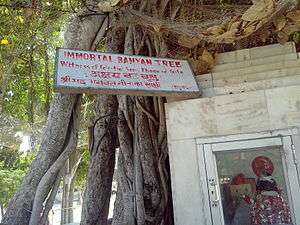Akshayavat
Akshayavat or Akshay Vat ("the indestructible banyan tree") is a sacred fig tree mentioned in the Hindu mythology.
According to a legend, once the sage Markandeya asked Lord Narayana to show him a specimen of the divine power. Narayana flooded the entire world for a moment, during which only the Akshayavat could be seen above the water level.[1] According to other stories, Muslim Mughal Emperor Jahangir tried to destroy the tree.
Prayagraj
A tree in Prayagraj has been described as Akshayavat in the Prayag Mahatmya of the Matsya Purana.[2]
In The Encyclopaedia Asiatica (1976), Edward Balfour identifies a banyan tree mentioned in Ramayana with the tree at Prayag.[3] Rama, Lakshmana and Sita are said to have rested beneath this tree.[1] The Chinese Buddhist pilgrim Xuanzang mentions a tree (a stump with few branches[3]) which was said to be the home of a man-eating demon. As part of a custom, some pilgrims would offer themselves at the nearby temple. Xuanzang mentions that the tree was surrounded with the human bones. Alexander Cunningham identified this tree with the Akshayavat at Prayag.[1] Rishabha (Jain tirthankar) is also said to have practised tapasya beneath the historical Akshayavat at Prayag.
Currently, a sacred fig tree located within the Patalpuri Temple at the Allahabad Fort is worshipped as the Akshayavat described in ancient texts. As of 2011, a permission from the Commandant of Allahabad Fort's Ordnance Depot is needed to visit this tree. On one day during the Kumbh Mela, the site is open to all the pilgrims. However, a popular opinion is that the Patalpuri Temple tree is not the authentic Akshayavat: the real Akshayavat is in another underground temple inside the Fort. When the British gained control of the Allahabad Fort after the Treaty of Allahabad in 1765, they did not want general public to access the sensitive parts of the fort. So, the shrine was moved to fringes of the fort compound, that is, the present-day Patalpuri Temple.[2] According to the Welsh travel writer Fanny Parkes, who visited both the tree sites in 1831, when the original Akshayavat chamber was closed, the local Brahmins set up the stump of a ber tree in Patalpuri. They claimed that it was a branch of the original Akshayavat that had penetrated through the walls. Parkes states that the local Hindus of Prayag knew about this and did not worship the false Akshayavat.[4] An 18th century map of the Fort from the British Library confirms this: the location of the original temple is shown in the center of the fort; while the present-day Patalpuri Temple is on the outskirts of the Fort. In the 1950s, Shiva Nath Katju also claimed that the "tree" placed in the Patalpuri Temple was only a log that was replaced by the priests every 4–5 years. The commander of the fort acknowledged his claim as true.[2]
Other places

A tree at Gaya, Bihar[3][5] and another tree at Varanasi are also worshipped as the Akshayavat. The Bodhi tree is said to be a manifestation of the Akashayavat at Prayag.[6]
According to Tibetan Buddhist tradition, Buddha is said to have planted a seed of the Prayag's Akshayavat next to Mount Kailash on a mountain known as the Palace of the Medicine Buddha.[6]
See also
- Kalpavriksha, a mythological, wish-fulfilling divine tree
References
- W. Crooke (2004). The Popular Religion and Folklore of Northern India (reprint ed.). Kessinger. p. 98. ISBN 978-1-4179-4902-1.
- Kama Maclean (28 August 2008). Pilgrimage and Power: The Kumbh Mela in Allahabad, 1765-1954. OUP USA. pp. 70–73. ISBN 978-0-19-533894-2.
- Frederick J. Simoons (1998). Plants of life, plants of death (illustrated ed.). University of Wisconsin Press. pp. 80–81. ISBN 978-0-299-15904-7.
- Fanny Parks Parlby (1850). Wanderings of a Pilgrim in Search of the Picturesque: During Four-and-twenty Years in the East. Pelham Richardson. pp. 215–216.
- The Sacred Complex in Hindu Gaya, Concept. Page 9.
- "Akshaya Vata: The Eternal Banyan Tree". The Himalayan Institute. 1 December 2001. Archived from the original on 2 November 2005. Retrieved 15 March 2011.